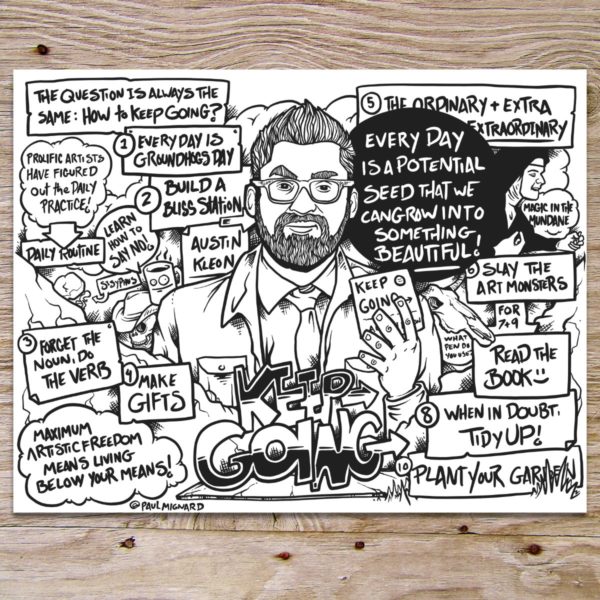
I dig this @paulmignard summary of my book Keep Going — especially the Sisyphus on the left and the Corita on the right.
I actually tried to make a drawing of Sisyphus for chapter one of the book, but cut it:
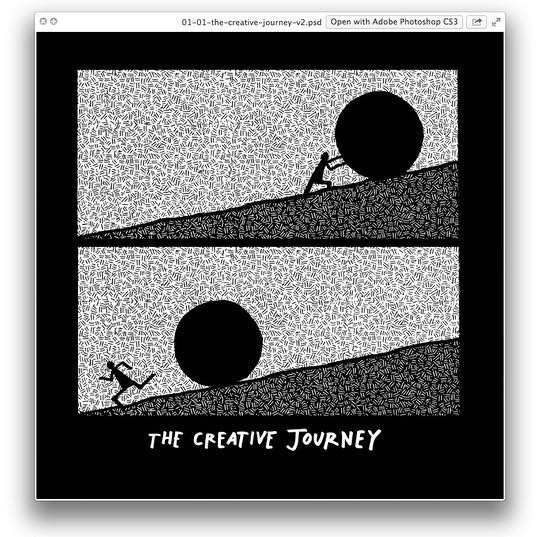

I dig this @paulmignard summary of my book Keep Going — especially the Sisyphus on the left and the Corita on the right.
I actually tried to make a drawing of Sisyphus for chapter one of the book, but cut it:

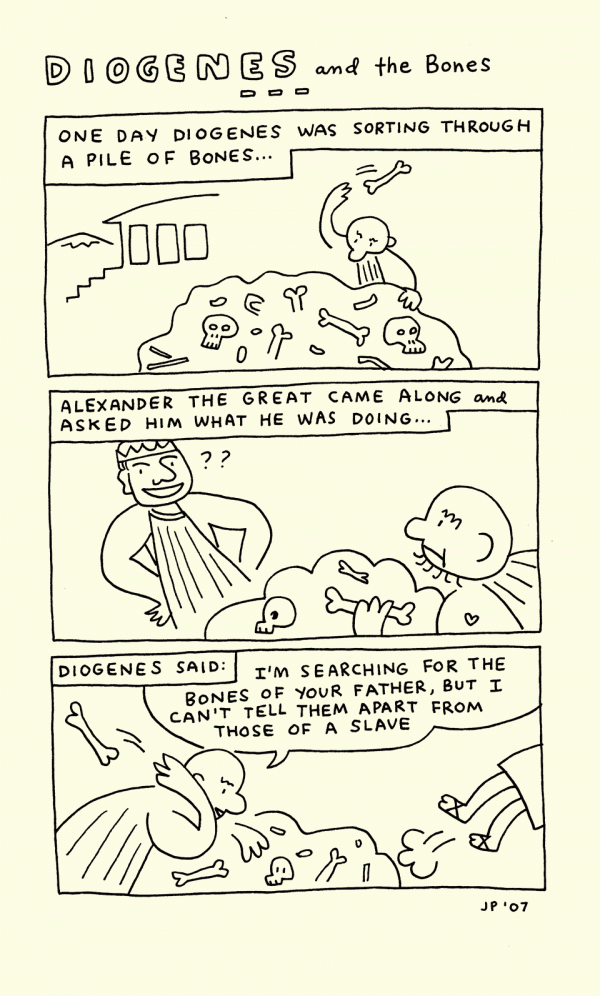
“Diogenes was the first, some might claim the best, stand-up comic.”
—Joyce Carol Oates
If you read Diogenes Laertius’s The Lives and Opinions of Eminent Philosophers, the stories about Diogenes of Sinope start to read like a joke book of one-liners:
Seeing some women hanging on olive trees, he said, “I wish every tree bore similar fruit.”
He was begging once of a very ill-tempered man, and as he said to him, “If you can persuade me, I will give you something.” [Diogenes] replied, “If I could persuade you, I would beg you to hang yourself.”
On one occasion he saw the son of a courtesan throwing a stone at a crowd, and said to him, “Take care, lest you hit your father.”
The cartoonist John Porcellino had the brilliant idea to turn a handful of these punchlines into single-page comics in a section of King-Cat #68, which is collected in his book, From Lone Mountain. (I would read a whole series of Porcellino comics based on his favorite philosophers: see his book, Thoreau at Walden.)
Here’s a comic not in the book, from King-Cat #70:
Jenny Odell writes about Diogenes in the chapter “Anatomy of a Refusal” in her book, How To Do Nothing, examining him alongside performance artists, Thoreau (Walden is much better if you think of it as performance art), Bartleby the Scrivener, and the comedian Tom Green.
Many people are familiar with “the man who lived in a tub,” scorning all material possessions except for a stick and a ragged cloak. Diogenes’s most notorious act was to roam through the city streets with a latern, looking for an honest man; in paintings, he’s often shown with the lantern by his side, sulking inside a round terra-cotta tub while the life of the city goes on around him. There are also paintings of the time he dissed Alexander the Great, who had made it a point to visit this famous philosopher. Finding Diogenes lazing in the sun, Alexander expressed his admiration and asked if there was anything Diogenes needed. Diogenes replied, “Yes, stand out of my light.”
Tim Kreider asked in his essay, “Power? No, Thanks, I’m Good”:
Who was ultimately more powerful: the conqueror Alexander, who ruled the known world, or the philosopher Diogenes, whom Alexander could neither offer nor threaten with anything? (Alexander reportedly said that if he weren’t Alexander, he would want to be Diogenes. Diogenes said that if he weren’t Diogenes, he’d want to be Diogenes too.)
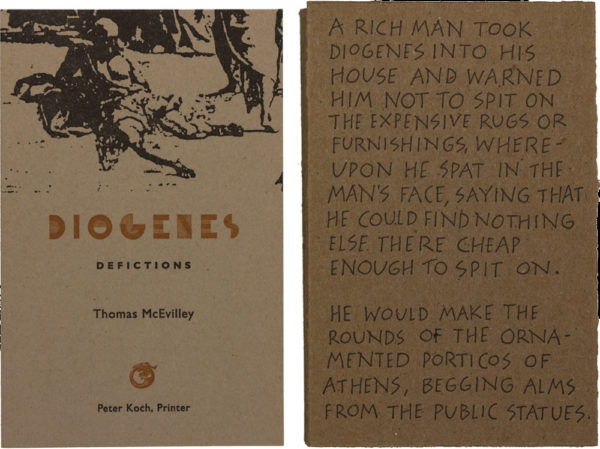
In a 1983 issue of Artforum, Thomas McEvilley called Diogenes “arguably the great prototype for much performance art,” and reframed a selection of Diogenes stories as performance pieces, or “Performance Philosophy,” later collecting them into an artist’s book, Diogenes: Defictions.
Some more of Diogenes’s greatest hits:
One day Diogenes was seen sitting in the public square all afternoon gluing shut the pages of a book.
When a play had just ended and the crowds were swarming out, Diogenes made his way into the emptying theater against the flow. When asked why, he replied, “This is the kind of thing I practice doing all the time.”
When a rich man took Diogenes into his house and cautioned him not to spit on the rugs and furnishings since they were very expensive, Diogenes spat in the man’s face and explained that it was the only thing there cheap enough to spit on.
Diogenes praised people who intended to get married, or go on a journey, or enter a profession, and being just about to do so, decided not to.
When he was captured by pirates after a shipwreck and put up for sale at a slave auction, the auctioneer asked him what he could do. “Govern men,” he replied, and told the crier to call it out in case anyone wanted to buy a master for himself.
One day Diogenes was seen making the rounds of the ornamented porticoes of Athens, begging alms from the public statues.
He would walk backward through the city streets.
I thought about Diogenes last night when I was watching David Shields’ excellent film, Marshawn Lynch: A History, with its clips of Joseph Campbell talking about the trickster and stand-up comedians like Dave Chappelle contextualizing the football player’s silence and refusals to engage with the media.
Which made it even funnier when I found this old tweet from Odell, with a .gif from the Rick James episode of Chappelle’s Show:
https://twitter.com/the_jennitaur/status/1016763504731119617?s=20
A message from Alasdair Gray’s mural in the Hillhead Subway Station in Glasgow:
Do not let daily to-ing and fro-ing
to earn what we need to keep going
prevent what you once felt when wee,
hopeful and free.
(For those who don’t speak Scottish: “wee” means “little.”)
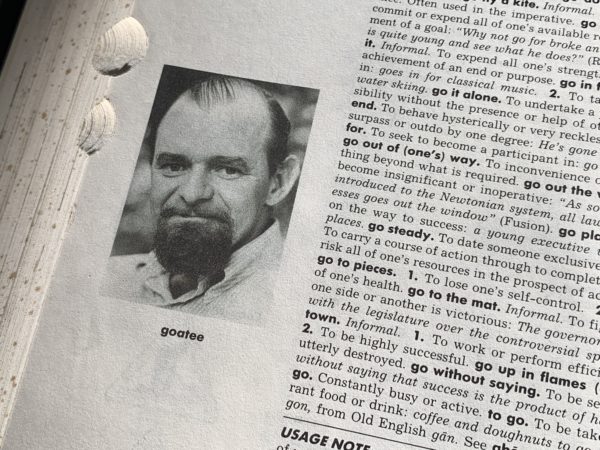
One of my favorite things is flipping open my paper dictionary to a random page and seeing what turns up. (See: bibliomancy.)
After Edward Carey (author of Little) finished writing his first book in 1999, he wrote to his hero, Alasdair Gray. This was Gray’s response.
…please tell anyone you know in the writing game that I’m too selfish to be of use to anyone. If you photocopy this letter and pass it around I will think it a favor.
That handwriting! Exquisite. I want to copy every letter.
I’d never heard of Gray or his work until a few years ago, when Elizabeth McCracken (author of Bowlaway, and, not coincidentally, Edward’s wife) sent me this charming video of him talking about his writing and art:
“I couldn’t make a living by either of them,” he said, “so the writing helped the painting and the painting helped the writing.”
I particularly loved his response to the ever-worn-out question, “Can writing be taught?”
Of course! I couldn’t write before I was was taught! That’s why they give it to you in primary schools. Writing and speaking are things that have to be learned first. Some people at a certain stage think that they don’t have to learn any more. If you’re very interested in words then you try to keep on learning more. And the best way, of course, is by reading other writers. Good ones! Or even bad ones are better than none to begin with.
Delightful video. Do watch.
Related reading: Edward Carey at the APL
This site participates in the Amazon Affiliates program, the proceeds of which keep it free for anyone to read.